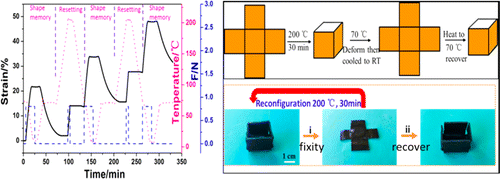Abstract: Conventional thermoset shape memory polymers can maintain a stable permanent shape, but the intrinsically chemical cross-linking leads to shape that cannot be altered. In this paper, we prepared shape memory graphene-vitrimer composites whose shape can be randomly changed via dynamic covalent transesterification reaction. Consecutive shape memory cycles indicate stable shape memory with undetected strain shift and constant shape fixity and recovery values (R-f > 99%, R-r > 98%). Quantitative characterization of shape reconfiguration by dynamic mechanical thermal analysis (DMA) shows prime reconfigurable behavior with shape retention ratio of 100%. Thus, the arbitrary 2D or 3D newly permanent shape can be easily obtained from a simple plain sample by facile thermal treatment at 200 degrees C above transesterification temperature (T-v). Besides, it is found that graphene-vitrimers show a ductile fracture in tensile test with a large breaking strain and classical yield phenomenon because of the well-dispersed graphene sheets in the vitrimer that endow effective stress transfer. As the graphene loading increases from 0% to 1%, the yield strength and breaking stain increase from 12.0 MPa and 6% to 22.9 MPa and 44%, respectively. In addition, graphene also serves as energy convertor to convert near-infrared (NIR) irradiation into thermal energy to induce a helix shape sample that is recovered totally within 80 s sequent NIR irradiation. These dual-triggered and reconfigurable shape memory graphene-vitrimers are expected to significantly simplify processing of complex shape and broaden the applications of shape memory polymers. KEYWORDS: Polyimide/epoxy resin, molybdenum disulfide, bonded solid lubricant coating, polyfluo-wax, friction and wear behavior Published in ACS APPLIED MATERIALS & INTERFACES, 8 (33):21691-21699; 10.1021/acsami.6b07403 AUG 24 2016
|
